
In 2024, SEO has never been more competitive. It often seems that only the biggest websites with the most money rank high in search engines. The reason it seems this way is because no one is sharing with you the insider information about how to increase search engine rankings. That’s why I have wrote this article. It is all about how to compete with them, get your content ranking high in Google, and, at the same time, improve your site’s usability.
The last part is very important: site usability. The more someone enjoys your website, the higher it seems to rank in search engines.
Key takeaways for improving your search engine rankings:
- Search engines want to send users to sites that answer the questions they are looking for, and they measure this by looking at bounce rates. Reduce bounce rate by: keep content fresh, improve readability, internal linking is essential, create a website better than anyone elses.
- Create a hierarchy for your website (cornerstone content) to make it clear what pages are most important. We focus on 5 – 10 articles that are our ‘ultimate guides’, which are well-optimized for search engines and monetized to make us money. Then, we link to these pages from all our other pages using their keywords.
- Make sure the website loads fast: switch to a better hosting company (we use Nexcess), enable caching, compress images, fix broken link errors, reduce excessive plugin use.
- Increase backlinks by creating the types of articles that rank high in Google (such as top lists, and use ContentShake to generate them for you).
- Conduct a website audit using SEMrush for free. It will tell you all the errors your website has regarding search engine optimization, which is a must-have for any website.
21 SEO Tips For Improving Search Engine Rankings Right Now
These 21 tips are the core of the SEO methodology that we recommend and implement for clients of our SEO agency partners.
I’ve compiled all the best practices to provide you with actionable steps to start ranking websites.
What’s included in our guide to increasing search engine rankings:
- 1) Keyword Research
- 2) Write SEO Friendly Headlines
- 3) Page Content
- 4) Post Slug
- 5) Page Speed
- 6) SEO Internal Linking
- 7) External linking
- 8) Fix 404’s (content you have deleted that Google still looks for)
- 9) Meta Data
- 10) The more backlinks the higher you rank in search engines
- 11) Tags
- 12) Image Optimization To Improve Search Engine Rankings
- 13) Mobile Optimization
- 14) Increase search rankings with a table of contents
- 15) HTTPS
- 16) Fix Duplicate Content
- 17) Pagination
- 18) Reducing Bounce Rate
- 19) HTML5 Sections
- 20) Prioritize your best content (cornerstone content)
- 21) Modernising outdated websites and freshen content
What works best: If you are wondering in which order to focus on improving your search engine rankings, I would say updating and making old content fresh is most important. Then user experience, followed by improving search engine click-through rate by improving meta descriptions and adding a table of content.
How To Improve Search Engine Rankings
1) Keyword Research
All your SEO decisions come from having the right keywords – from the topics you’ll be writing in your content strategy, to the pages you’ll be optimizing.
Keyword research is about finding the balance between relevance and search volume.
It’s important to choose keywords that are relevant to your target market, as well as keywords with enough traction and gets a significant amount of queries. These are your low hanging fruit and the ones that make up your bucket list of target keywords.
Here’s an example of the bucket list of keywords, and I’ll dive in a bit how we came up with this list:
Your most important tools when doing keyword research are Google’s Keyword Planner and SEMRush All-in-one Marketing Toolkit.
The first thing you need to do is see is determine the top performing pages of the website. SEMrush provides you a list of your top performing pages, as well as keywords that are ranking for those pages.
This is where critical thinking comes into play. Most of the keywords that appear there might not be relevant to the website, so you need to cherry pick the ones that are relevant and have a high search volume. Add these to your bucket of keywords, then highlight the ones that you want to rank for the most.
The next thing you want to do is build your keyword list. That’s where Google Keyword Planner and SEMrush becomes handy tools. The process is the same as how you choose your initial keyword list—go to Google Keyword Planner and plug in your keyword to see other keyword suggestions that you can add to your list.
When I write articles (and when I was modenising over 300 old articles), I used SEMrush keyword tool to work out what search terms I wanted to rank for.

Below you will see how by using this tool you get to see all the search terms related to the one you are searching, as well as how many people are searching for them in the search engines. Useful isn’t it?
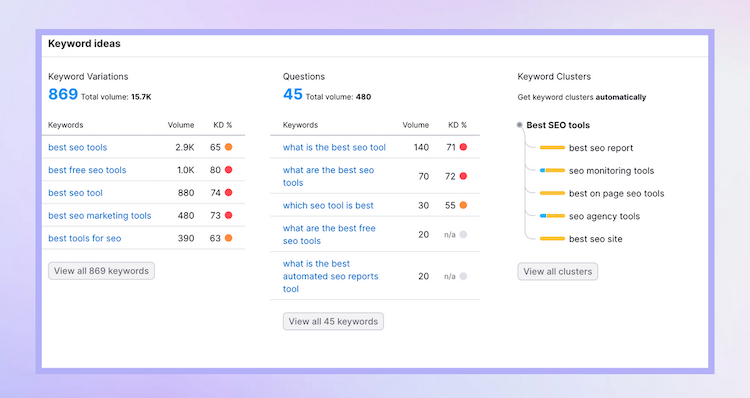
How to rank your articles for each keyword:
You want to create multiple pages if you want to rank high for numerous related keywords. So, for example, instead of writing the ultimate guide to make money online and trying to rank for various keywords such as:
Make money online
Ways to make money from a website
How to monetize your blog
Affiliate marketing
You write several articles, each on a different specific subject. That is the only real way to compete for search terms. Each URL should be the keyword, so for example:
Incomediary.com/make-money-online
Incomediary.com/ways-to-make-money-from-a-website
Incomediary.com/monetize-your-blog
Incomediary.com/affiliate-marketing
When you write these articles, you must link to each article inside them and call the link the page’s name. Google loves this.
To determine which keywords to choose, you must first type them into the SEMrush keyword tool. If you are struggling to find keywords with a lot of traffic (which is what you want), look at similar articles that rank in Google that your competitors have written.
Keyword research (an example of interlinking with a keyword) is the easy part of search engine optimization. The challenge is ranking for your keywords.
Suggestion for identifying which search engine rankings to improve: Go to SEMrush and, using the keyword search tool, go through all your rankings and identify high-volume traffic for anything you rank between 10 – 30 for. These are your low-hanging fruit search terms that will be much easier to increase than going after completely new keywords. A few changes to these articles, a few more internal links, and a couple of incoming links may make all the difference between getting 10 visitors a month and 500 visitors to one of your pages.
Use AI to generate keyword ideas for better search engine rankings
With artificial intelligence becoming more powerful every minute, it’s becoming a must-have tool for anyone who wants to improve SEO, especially for keyword research.
Using a chatbot, ask for similar keywords on a topic you want to write about. For example, I asked:
List 10 keywords related to “how to make money online”, focusing on search terms, questions and long tail searches.
I received a list of keywords, including:
- How to start an online business to make money
- Tips for earning money online without investment
- Making money online through freelance work
Then, using SEMrush, I saw which keywords had the highest search levels, and I used these keywords either as the titles of articles or subheadlines within articles. It saved me a bunch of time because I didn’t have to think about it or conduct keyword research.
2) Write SEO Friendly Headlines
One of the struggles in ranking a website is writing a compelling headline – one that has the right keywords and resonates with visitors.
Eight out of 10 people will read a headline, but only two will actually proceed past the headline .
How do you compromise a read-worthy headline and a rank-building headline?
You can go about writing highly-effective headlines in a few ways:
- Start with a working title: You don’t need to finalize your headline when you start writing. A working title will suffice. This can be as straightforward as possible and include your keywords, so you can determine the best way to present what the page is about.
- If it sounds off, don’t force it: Keywords are necessary to your headlines to make the page rank higher, but the problem with most keyword insertions is that they appear forced and awkward, sometimes not even making any sense.
- Optimize for search and social: Straightforward titles work in SEO, but might not always be applicable in social. Your headlines should be playful and attractive, but still having a direct tone that gives users a hint of what the content is about. Find the balance between optimizing for search and social, and sprinkle it with your target keywords.
- See how others are doing it and learn from them: This is why you have tools like Buzzsumo to show you content that has the highest engagement. Look at the top results, analyze how their headlines are written, and see how you can apply to your strategy.
Popular styles of headlines that have keywords in them are:
Top 21 Strategies For Increasing Search Engine Rankings
How To Be Successful In Life: 33 Strategies
How to Monetize a Blog: 17 Best Strategies for 2024
10 Best Tools to See How Much Traffic a Website Gets
How To Sell A Website For The Most Money Possible
I have boldened the keywords so you know what each article is trying to rank high in search engines.
Bonus tip: It’s important for SEO not to have titles that are too long, again using SEMrush audit tool I was able to locate any articles that required fixing, see below:
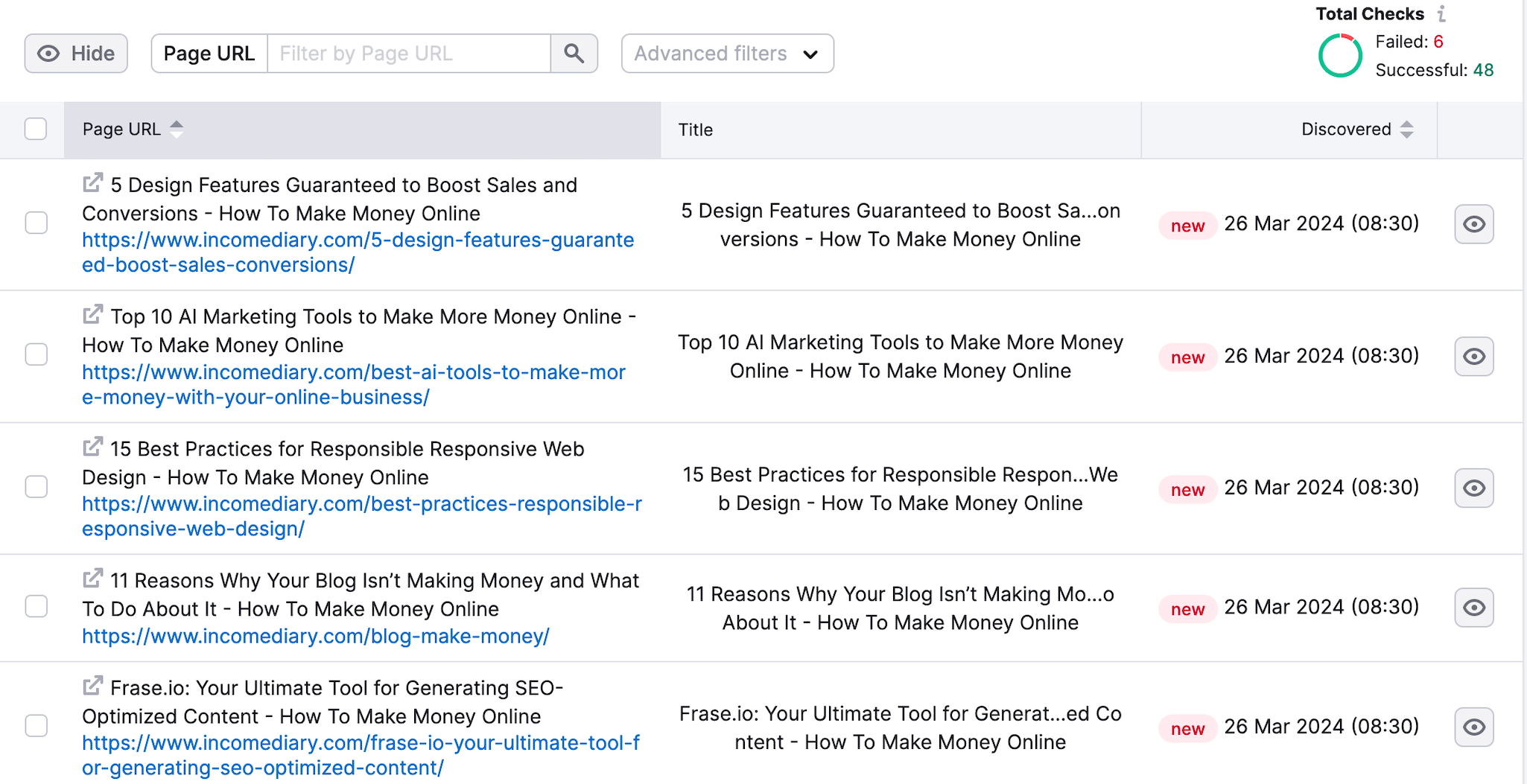
3) Page Content
The best bit of advice for creating content that ranks high in search engines: Give readers what they want as quickly as possible.
We will shortly establish that one of the most important ranking factors is your bounce rate, which is how long someone stays on your website. Writing great content is the best way to keep people on your website and keep them coming back.
It’s not just great content; it’s how you deliver it.
Over the last few years, I have become increasingly dissatisfied with the content delivered on blogs, and when I come across a site that is poorly considered for users, I click back straight away. So, with that in mind, let’s talk about how to create content that readers want to read that ranks high in search engines.
10 Ways to improve search engine rankings with better content:
- Search engines want to give users the content they are looking for as quickly and accurately as possible. With that in mind, it’s best to shorten introductions and reduce clutter at the start of articles (such as images and advertising). This will mean visitors get value quickly without having to scroll, and they are more likely to stay and continue reading.
- Improve your image-to-text ratio. Both are important; having too much of one and not enough of the other isn’t good. I recently clicked through in search results to an SEO blog, and this blog has far too many images to text, so I clicked back because it made it impossible to find the information I was looking for.
- Use headlines that answer questions. Many users just skim an article before committing to reading it; by writing good headlines, they will see someone they want to read. Some blogs have a habit of keyword-stuffing their headlines, which makes them unreadable. So, for example, the headline for this section is ‘page content’; if I had a headline for each section in this article that read ‘how to increase search engine rankings with page content’, it would all become a blur and difficult to read.
- Remove outdated content that serves no purpose. If readers come across it, they may think less of your website and leave. It could also hurt your overall SEO.
Ultimately, the websites that rank are those that provide high-quality, relevant content to search users. When we say high-quality content, it should:
- Be unique – no duplicate anywhere on the site.
- Align with the search intent of the user and provides them with the information they’re looking for.
- Doesn’t have grammatical or spelling mistakes.
- Includes relevant keywords in the title, headers, and body.
- Be accurate and with links to high-authority websites.
- Prompts users to complete a specific action and directs them to the next steps in their customer journey.
Running a website or an online business is time-consuming, and if you are anything like me, you will want to outsource tasks when possible. We have bought hundreds of articles, and each one has gone on to attract millions of visitors. If you want to hire someone to write a good article quickly, then I recommend FatJoe’s writing service.
Alternatively, you could use ContentShake AI (by SEMrush), which generates unlimited, ready-to-publish content using artificial intelligence. It’s so much better than any other tool I have seen—it doesn’t just create headlines, insert keywords, and write the article; it even creates images. That’s why we rate it as our favourite AI content creation tool.
Is Word Count Important For High Search Engine Rankings?
Quality or quantity?
That’s always going to be a debate among SEO professionals. Some will say that short is better, as users don’t have the time to scroll a wall of text. Long-form content, on the other hand, provides you with more opportunities to insert target keywords. Ideally, you want a page to have at least 1,000 words of high-quality content.
Don’t use the same keywords for more than one article
Don’t forget that each article or page on your website should not compete with each other. For example, two articles should not compete for the same keyword. This also applies to how you link internally.
If you have two articles about how someone could increase backlinks to their website, you need to either delete one, merge the two or change the focus and keyword of one article.
So, for example, instead of having two articles for backlinks, call one backlink and the other link building.
4) Post Slug
A post slug is the part of the URL that comes after the domain name and shows a particular section of the site. This is one of the things that users see when they do a search.
Now, compare these two post slugs:
https://ift.tt/QqNhH4f
https://ift.tt/Hju7RTW
Which of the two do you think is likely going to get more visits?
If you guessed the second one, you’re on the right track!
It’s easy to optimize post slugs, but this is often overlooked by website owners. What they end up with is a jumble of words – or sometimes, numbers and symbols – that don’t make sense and are hard to remember.
Here are a few pointers when optimizing a post slug for higher search engine rankings:
- Set the right permalink structure: The permalink is the full URL of any page or post of a website. It includes the domain name and the specific page. The permalink structure should match the goals of the site.
- Keep it short and easy to read: You want a post slug that’s easy to read and remember, but it should still describe what the post is about. Remove stop words and unnecessary articles, such as “the”, “and”, “a”, and “an” as much as possible.
- Use target keywords: Post slugs that contain target keywords are more likely to rank on search results and bring more qualified traffic to the page.
- Don’t use the same slug for different pages: The slug should be unique to the page that you want to rank.
IMPORTANT: Think before publishing any page or post because changing it later is not a good practice and will require you to do a redirect. Moreover, the site might lose SEO momentum if you change or remove the permalink of the target page.
5) Page Speed
To create a positive user experience and improve website ranking on search engines, it is crucial to optimize website speed. John Mueller says a page load time below three seconds is ideal (40% of people leave a website if the site takes longer than 3 seconds to load). I think the aim should be to have your website load in around 1 second. So, how can you improve your website’s page speed?
Begin by assessing the website’s content. Do you have too many images or Flash content? Which plugins are in use?
Experts suggest that images comprise over half of a website’s weight, so optimizing them is essential. Images should be in JPEG or PNG format, and compressing them before uploading is recommended.
Minifying JavaScript, HTML, and CSS is crucial to reducing client-server requests for website content loading. However, it is essential to be careful during the minification process to remove only unnecessary codes.
It is also advisable to reduce the number of plugins on the website. If the plugin requires complex operations and external APIs and loads many content assets or scripts, consider removing it from the site.
The most important things to get right when optimizing a website to load faster:
- Enable caching
- Use a Content Delivery Network
- Optimize your images
- Enable compression
- Reduce Pointless redirects
- Reduce Excessive usage of social media scripts
- Fix broken links (404 errors)
- Take care of your page size
- Leverage Browser Caching
- Select your hosting company wisely (we use Nexcess)
Just so you know, when I switched to a better web host, I noticed my website became much faster, the bounce rate decreased, and search engine rankings increased.
One way to check how fast your website is loading and for errors slowing it down is to use Semrush’s Site Audit tool. This tool has over 140 on-page and technical SEO checks to help you identify potential issues. To check a website’s loading speed, access the Site Audit tool, enter the desired URL in the search bar, and click the “Start Audit” button.
6) SEO Internal Linking
Internal links on websites serve several important purposes. They help users navigate between pages, establish the information hierarchy, and distribute link equity across the site. However, some SEO specialists overlook the significance of thoughtful and strategic internal linking.
Effective internal linking is crucial for improving a website’s search engine rankings. Conducting comprehensive keyword research is essential before implementing an internal linking strategy. This allows you to pinpoint your website’s most relevant pages and blog posts and select appropriate anchor text for linking. By ensuring that relevant pages contribute enough link equity to your chosen keywords, you can develop a comprehensive internal linking structure that enhances your website’s overall SEO performance.
We have already told you about keyword research, writing SEO-friendly headlines, creating SEO-friendly content, and choosing the right post slug. Really, interlinking is just an extension of this.
Let’s use the keyword make money online.
- Headlines should include the words: make money online.
- Content should use the words: make money online and synonyms such as making money online, earning money online, make more money online.
- URL should be: website.com/make-money-online/
When you link internally to your ‘make money online’ article, you want the text to say Make Money Online, or one of its synonyms. Google likes this (they don’t like it with backlinks, though, so avoid it when link-building).
We choose between 5 and 10 articles on each of our blogs as the focus of our interlinking, monetization and SEO efforts. See below how we often link from more than 40 articles to one of these ‘main articles’. We link so much because it works.

If you are looking for pages on your website with a low number of internal outgoing links, you can see these pages using Yoast SEO. Just go to posts and then screen options. Then you should see something like this:
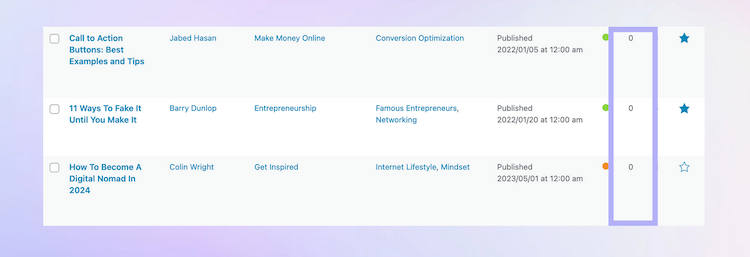
Then, go to each article, start adding those links, and watch the traffic increase and your search engine rankings improve.
When it comes to internal linking, it’s important to avoid using redirects whenever possible. Redirects can impact the flow of link equity and dilute the authority passed through the links. Instead of using redirects, aim to link directly to the target page. To see which pages have redirecting links, look at your SEO audit in SEMrush, as seen below:
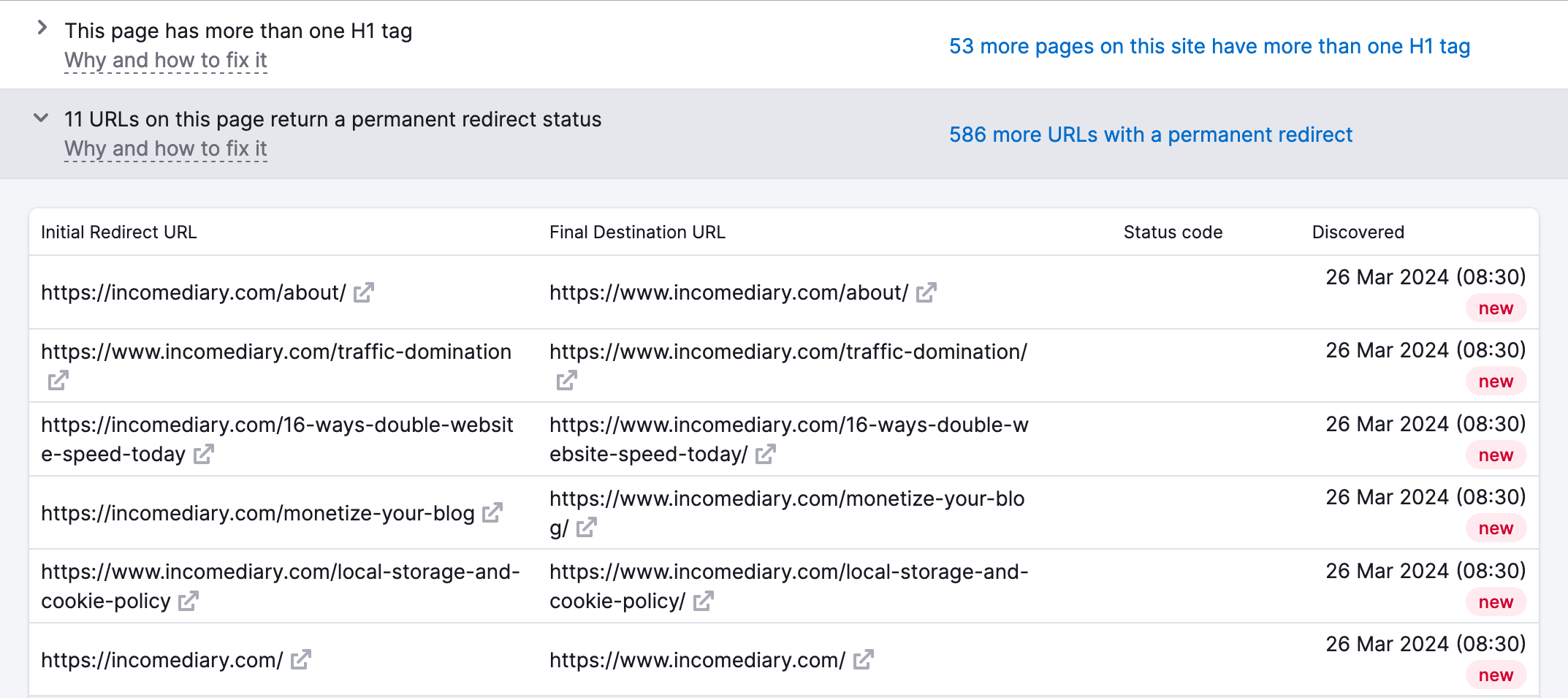
7) External linking
When it comes to external linking, it’s important to provide your visitors with additional points of reference for verifying information on your website. It also helps search engines identify what your website or articles are about. There are two types of external linking: inbound links, where another domain links to your website, and outbound links, where your website links to another domain.
Now, when should you use a dofollow or nofollow link, and what are they?
A dofollow link is a hyperlink that search engines can follow, which passes link equity (authority), while a nofollow link is a hyperlink that does not pass on link equity to the destination URL.
You should opt for a dofollow link when you want search engines to drive link juice to your website from an external source with a high domain authority. On the other hand, a nofollow link indicates to search engines that they should not follow a website you are linking to, essentially signalling, “Don’t count this link.”
We nearly always use dofollow links.
8) Fix 404 pages (content you have deleted that Google still looks for)
It’s common for broken links to appear when a page is removed, or its URL is changed without a proper redirect. When a user clicks on a broken link, they are directed to a 404 page, indicating that the requested page is unavailable on the website.
Broken links can negatively impact user experience, increasing the website’s bounce rate. When users are unable to find the information they need, they tend to abandon the site. Additionally, having too many broken links can harm the website’s SEO rankings, as search engines may devalue a website with broken links.
To discover 404 pages, you have two options: log into your SEMrush account and go to CopilotAI, which will display all the broken links there. Alternatively, you could log in to your Google Search Console and then click pages, which are located on the left side under indexing. Once on this page, click on Not Found (404).
The page should look something like this:

Now you want to either use Yoast SEO redirect or go to plugins and search for a redirect plugin and use that.
How to Fix Broken Links
- Make sure the URL is formatted correctly.
- Add a redirect to old, broken links and direct them to relevant pages on the site.
- Remove the anchor text directing to a broken link if the page no longer exists.
9) Meta Data
Meta Data is composed of two parts – title and description. Some SEO professionals add Meta keywords in their Meta Data, but Google says it doesn’t consider these in ranking search results.
A website’s Meta Data should entice users to click and provide them with information about the page. The Meta Data appears as a snippet of text on search results and on the HTML code of the website.
See how the Meta title and description are written for the results on the top positions. These show snippets that match the intent of the user and provide enough information on what the page is about.
Here are a few best practices to follow when optimizing the Meta Data of a website:
- Use your target keywords in your Meta Data—ideally, the keywords should be on the left-most side.
- Don’t write descriptions and titles that are too long, as this will cause the Meta Data to appear truncated.
- Each title and description should be unique to the page.
- Write compelling copies for the title and description to maximize click-through. The title and description should provide information that matches the search queries of users.
Below is an example of what a meta description looks like in search results:

Does not having a meta description affect search engine rankings?
No, they affect click-through rates, not your search engine rankings.
A meta description is a summary of the content on a web page that appears below the page title in search results. It gives users an idea of what the page is about and can entice them to click through to the website. If a web page does not have a meta description, search engines often pull a snippet of content from the page to display in search results. This may not accurately represent the page’s content and could deter users from clicking through.
So, if you want to increase the likelihood of someone clicking through while searching in Google, write better meta descriptions.
10) The more backlinks the higher you rank in search engines
Backlinks are so important. Only a few links could be the difference between 1000 visitors from search engines every month and 10,000.
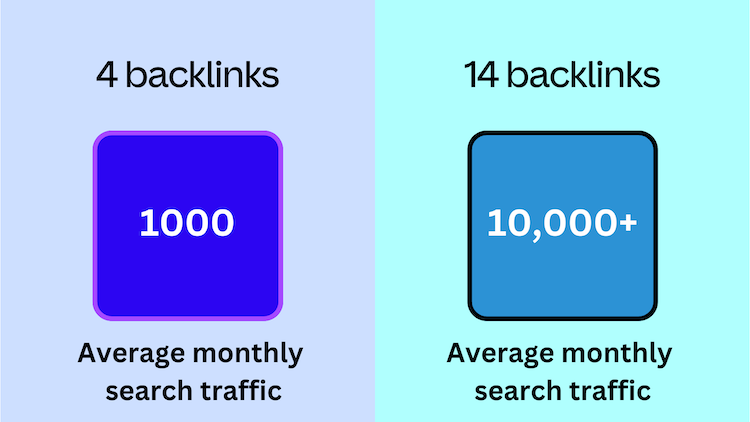
When it comes to getting backlinks, it starts with having something that someone could link to. Most of our backlinks are to our top list-style articles (read this guide about how we write them).
Once you have great content, in our experience, the best way to boost backlinks for high search engine rankings is to use the following techniques:
- Press releases
- Guest blogging
- Content syndication
If you want to outsource these tasks, use FatJoe.
Alternatively, you could try backlink outreach to get links your competitors already have.
Competitor outreach
What is the most important element of getting high Google rankings? It seems to be the amount of links your website has. It shouldn’t be; good content should come first, but it doesn’t.
Of course, many things are important for high search engine rankings, such as on-site optimization and the content itself. However, if you get all that right and get no links, you won’t rank high on Google, so how important is it really?
The problem for most websites is they are unable to afford to buy links. At least not quality ones. Large websites make so much money that they have huge budgets, and there really is no way to compete with them in terms of spending money.
So the question is, how does someone get lots of links without buying them or having contacts in the industry to link to you in the first place?
By email outreach.
First, you have to write an incredible article for your website.
Next, go to SEMrush and look for pages that rank for the search terms you want to rank for. Then, use their competitor analysis tool to see what sites are linking to them.
Now, email each website and let them know that you have a similar, more up-to-date article that you think they should link to instead or as an addition.
It works surprisingly well.
One last recommendation. If you are not keen on contacting all these websites yourself, FatJoe are offering a low-cost solution to contact them for you.
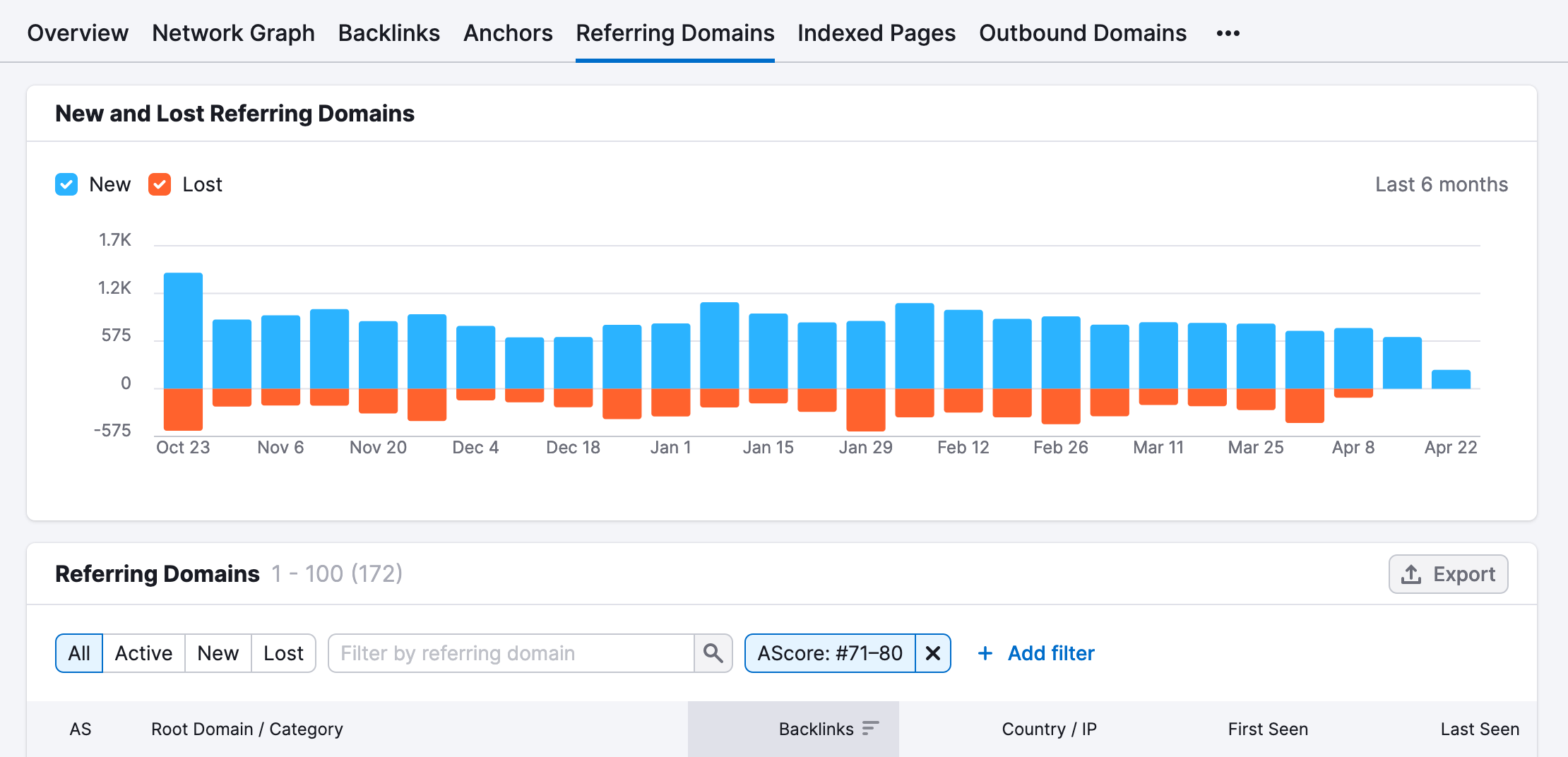
Lastly, social media shares also count and contribute to a page’s search engine ranking. SEMrush Social is an excellent tool for automating and scheduling your social media, which is a must if you want to get lots of likes and shares. As we are talking about it right now, we would really appreciate it if you shared this article on your social media.
Bad links reduce your search engine rankings
Google has made it clear that it doesn’t want you buying links to artificially manipulate rankings in its search results. These types of links include paid, low-quality directory or bookmark site links and keyword-rich forum comment links.
If you’re unsure whether Google has flagged some of your linking practices as problematic, you can easily check by logging into your Google Console account. Navigate to the ‘Manual Actions’ section on the left side. If everything is in order, it should look like this:

If you have bad links, you are supposed to contact the website and ask them to remove them. If they refuse, then disavow the links in Google Console. Be careful, though; if you don’t know what you are doing, disavowing links could lead to good links being removed, so I recommend you seek advice before doing anything.
SEMrush has a backlink audit tool that allows you to identify bad links more easily and then remove them. If you have bad links, I would first run this audit to see.
11) Tags
Optimizing tags is one way of improving how a website communicates with search engines. These tags are not visible to users, but they are to search engines. When search engines crawl a site and find these tags, they get information on what the website is about.
Here are some important tags you need to optimize:
Title tag: Each page should have a unique title tag, with only 50-60 characters (keywords included). What you put in the title tag is what will appear on search results. While it’s important to put in keywords, it’s better to make the title tag appear natural.
Header tags: Depending on how you structure your page, you can have H1, H2, H3, H4 tags, and so on. The idea about using header tags is to organize the content of the page. H1 tags usually serve as the title of the body content, while the subsequent header tags are the subheadings. Use your main keywords on H1 tag and embellish the subsequent tags with secondary keywords.
Your blog will automatically make the post title an H1 tag, so there is no reason to use H1 tags anywhere within an article. We noticed recently that some of our guest bloggers were using H1 tags inside their articles by using SEMrush’s audit tool; see below:

By identifying these pages, we were able to update them, making it easier for search engines to determine what an article was about without conflicting information.
Schema tags: Optimizing the site’s schema tags improves a search engine’s ability to understand what the website is about and improves how the website is displayed on search results.
Nofollow link tags: Nofollow tags are important if you have backlinks that you don’t want search engines to count. Use this tag if you have links going to websites with a low domain authority.
See below how we track external links with nofollow attributes using SEMrush.
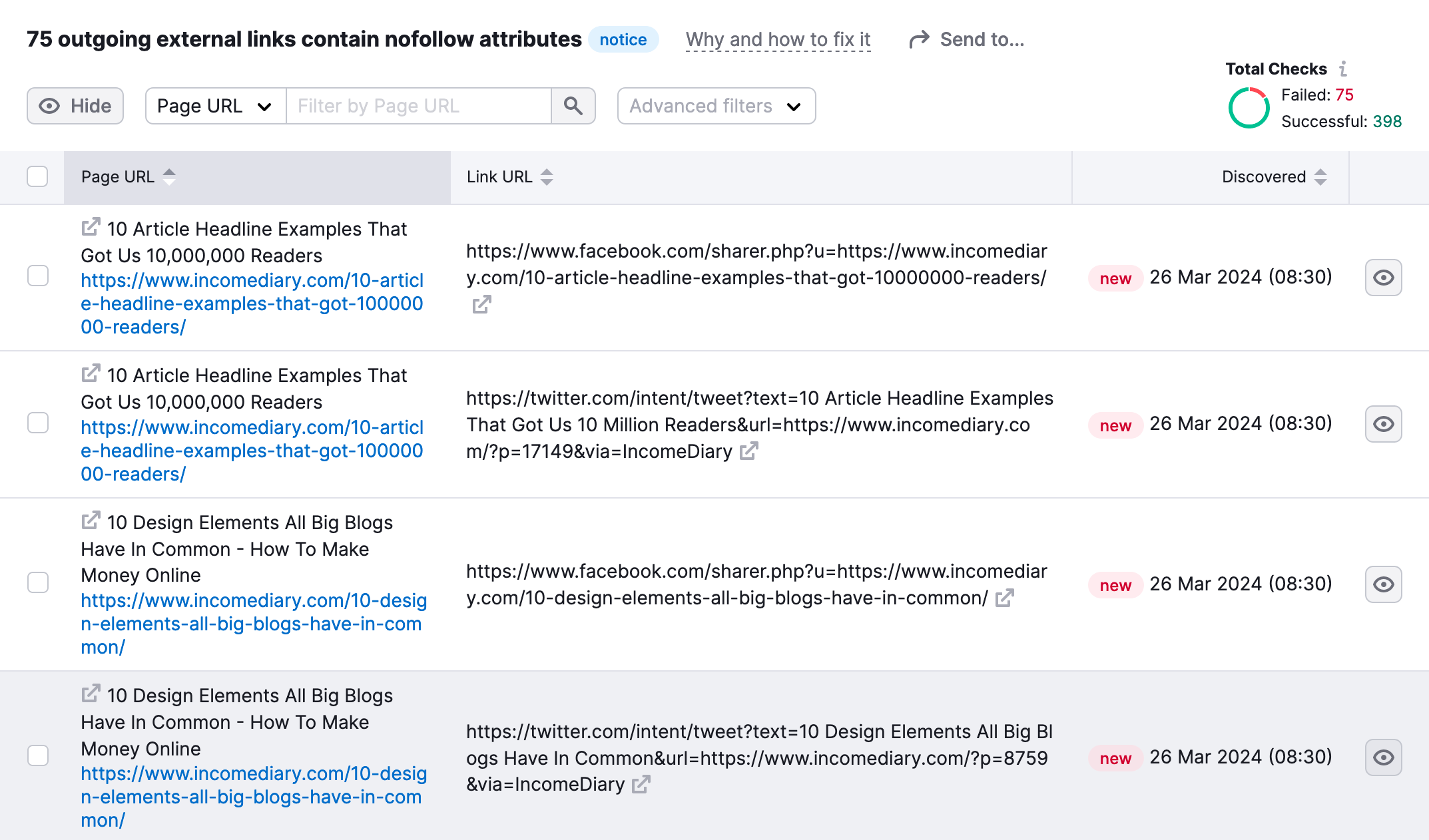
Anchor text tags: When linking, pay attention to the anchor text. Your anchor text should provide context to where you’re linking; otherwise, search engines won’t see the connection and relevance of the link. Below is another screenshot from SEMrush, it is able to show me all pages missing anchor text.
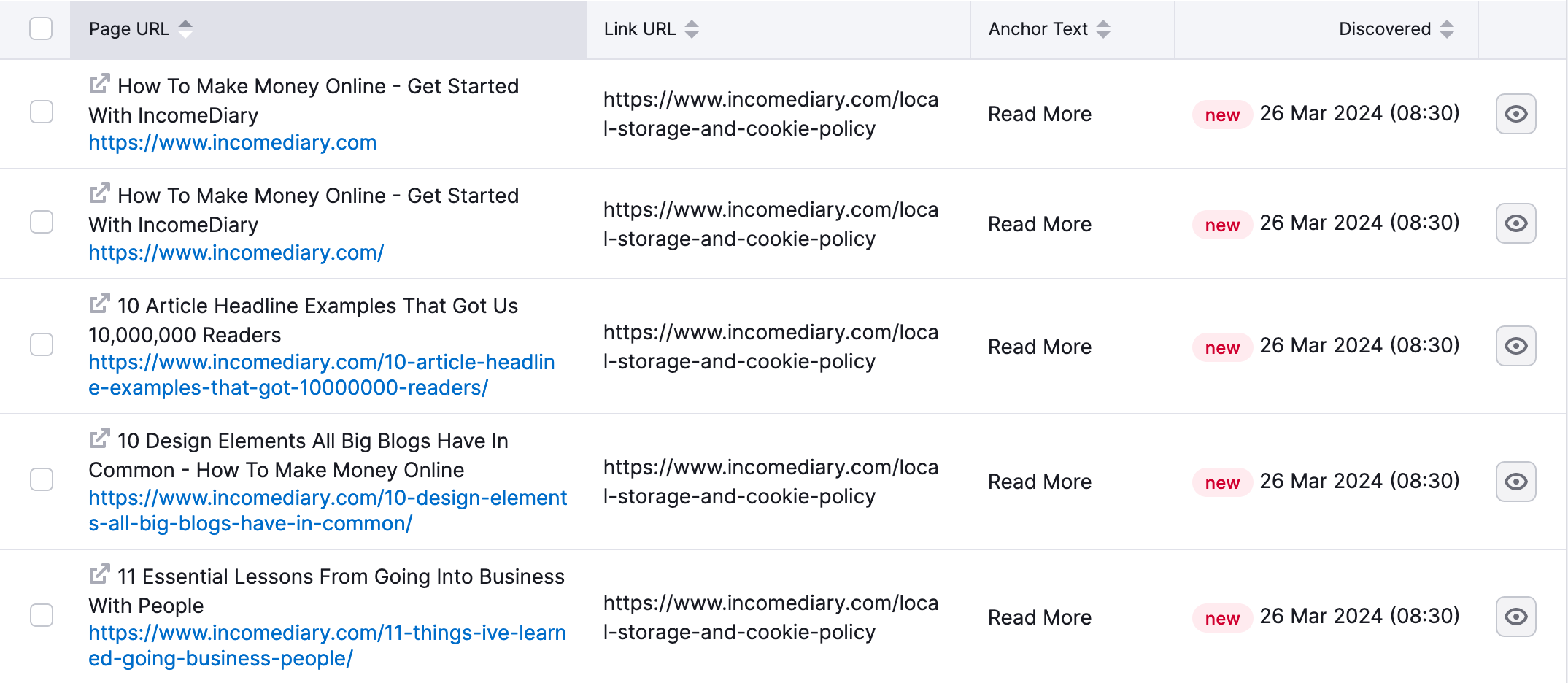
Canonical tags: These are used if the website has duplicate pages. You add this tag to help search engines identify which URL to consider as the master page among the duplicates.
Do a deep dive of the website to ensure its tags are optimized appropriately. Use Yoast for an way of adding tags on the website.
12) Image Optimization To Improve Search Engine Rankings
Google doesn’t have the ability to understand what the image is and how it relates to the page, but you can do this by adding alternate text or “ alt” text to images. The alt text provides a short description that appears on the image’s code, so search bots can “see” and “understand” what is being shown.
Another attribute that you have to optimize is the image title. The image title doesn’t appear when the image doesn’t load or appear; it appears when a user hovers over the image.
This is how the HTML image tag should look like:

One way to determine if your site has missing alt text is through SEMrush’s SEO audit tool. This can do a quick crawl of your site and then show a list of all images that are missing the alt text. This makes it easier to check which image doesn’t have an alt text and which needs improving.

Pro-tip : When uploading images, rename the image files with relevant keywords or key phrases that you’re targeting.
Apart from using proper image title attributes and alt text, it’s also important to use images that don’t have a heavy file size. Heavy images will make the website load slower and cause users to bounce from the site. Before uploading, compress the image to reduce its file size.
Tools like TinyPNG.com are handy for compressing images.


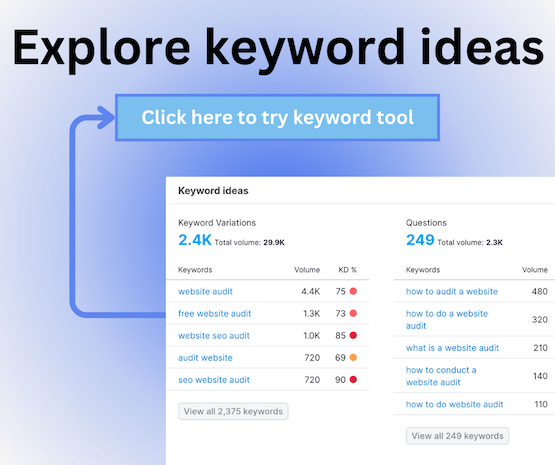

0 Comments